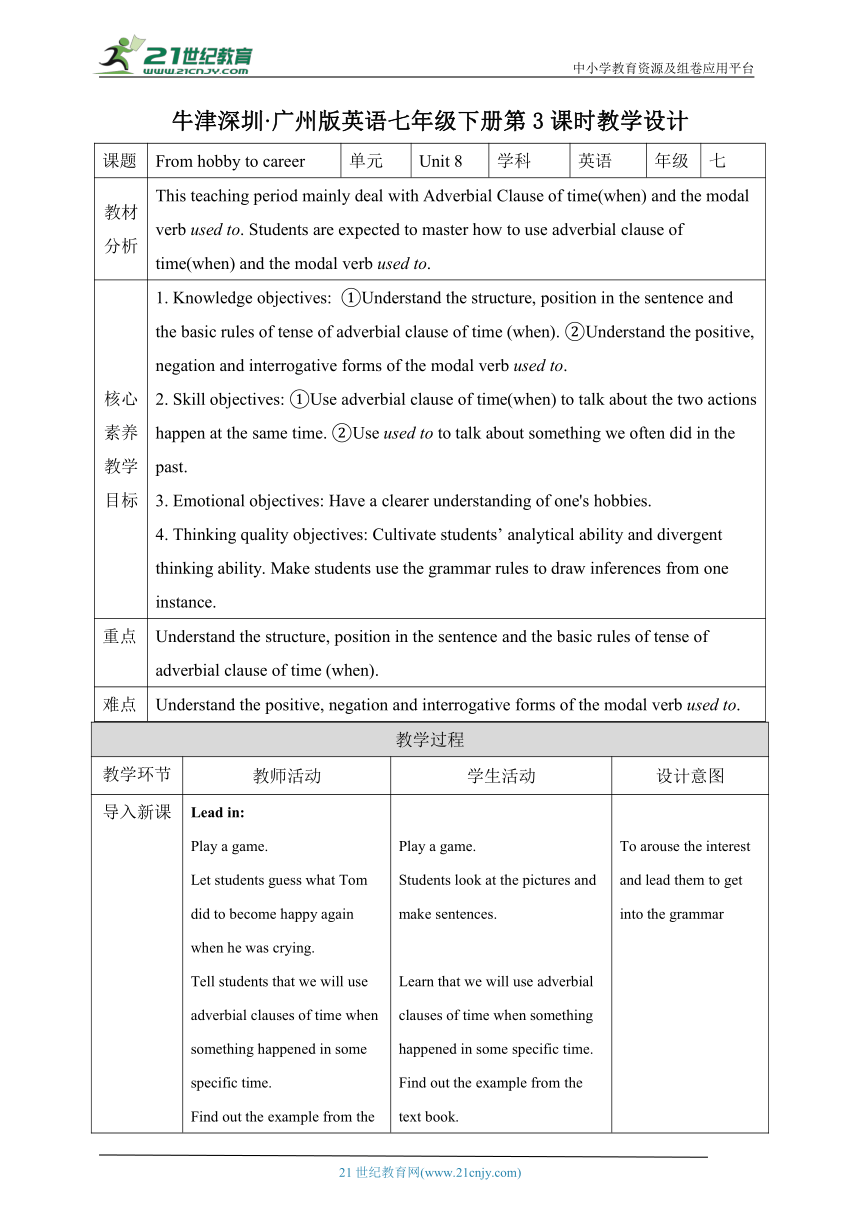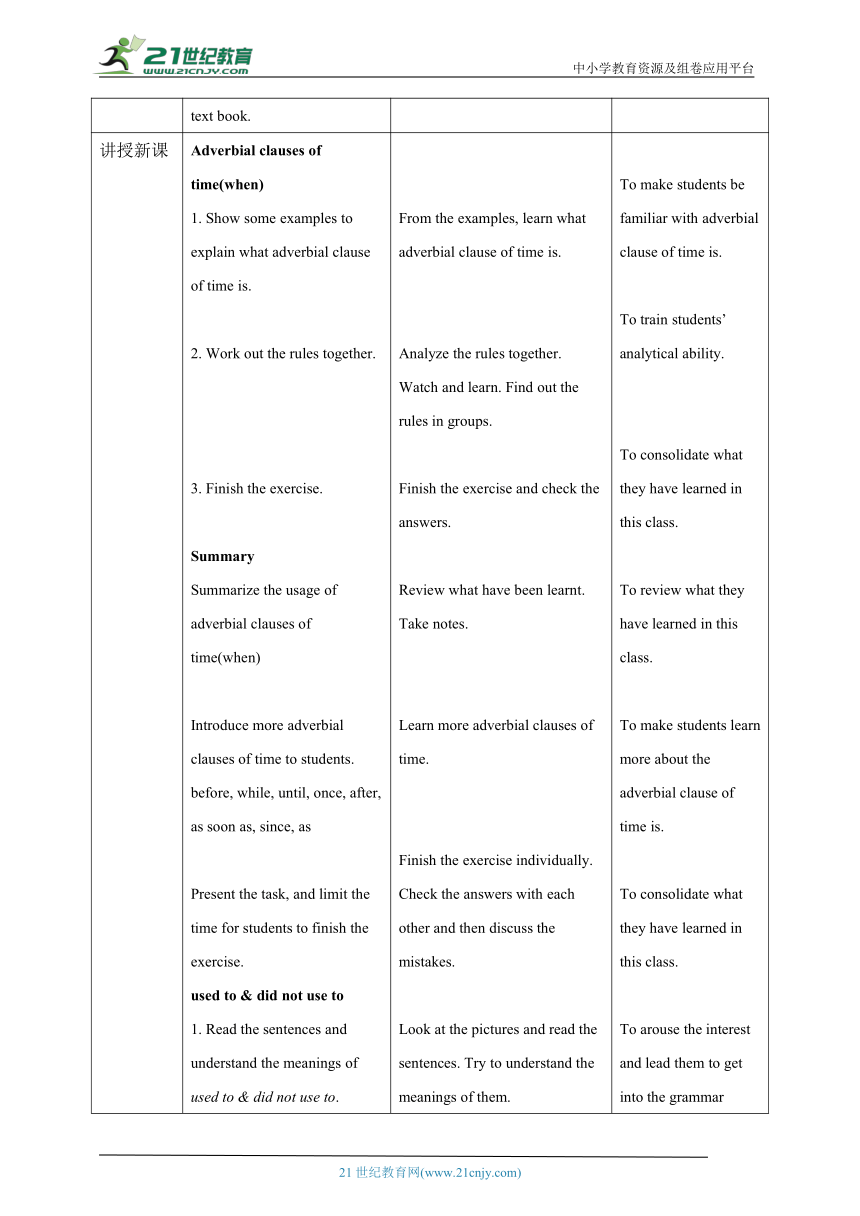【核心素养目标】Unit 8 From hobby to career 第3课时Grammar教案
文档属性
| 名称 | 【核心素养目标】Unit 8 From hobby to career 第3课时Grammar教案 |  | |
| 格式 | doc | ||
| 文件大小 | 1.2MB | ||
| 资源类型 | 试卷 | ||
| 版本资源 | 牛津深圳版 | ||
| 科目 | 英语 | ||
| 更新时间 | 2023-05-19 15:26:21 | ||
图片预览


文档简介
中小学教育资源及组卷应用平台
牛津深圳·广州版英语七年级下册第3课时教学设计
课题 From hobby to career 单元 Unit 8 学科 英语 年级 七
教材分析 This teaching period mainly deal with Adverbial Clause of time(when) and the modal verb used to. Students are expected to master how to use adverbial clause of time(when) and the modal verb used to.
核心素养教学目标 1. Knowledge objectives: ①Understand the structure, position in the sentence and the basic rules of tense of adverbial clause of time (when). ②Understand the positive, negation and interrogative forms of the modal verb used to.2. Skill objectives: ①Use adverbial clause of time(when) to talk about the two actions happen at the same time. ②Use used to to talk about something we often did in the past.3. Emotional objectives: Have a clearer understanding of one's hobbies.4. Thinking quality objectives: Cultivate students’ analytical ability and divergent thinking ability. Make students use the grammar rules to draw inferences from one instance.
重点 Understand the structure, position in the sentence and the basic rules of tense of adverbial clause of time (when).
难点 Understand the positive, negation and interrogative forms of the modal verb used to.
教学过程
教学环节 教师活动 学生活动 设计意图
导入新课 Lead in:Play a game.Let students guess what Tom did to become happy again when he was crying.Tell students that we will use adverbial clauses of time when something happened in some specific time.Find out the example from the text book. Play a game.Students look at the pictures and make sentences.Learn that we will use adverbial clauses of time when something happened in some specific time.Find out the example from the text book. To arouse the interest and lead them to get into the grammar
讲授新课 Adverbial clauses of time(when)1. Show some examples to explain what adverbial clause of time is.2. Work out the rules together.3. Finish the exercise.SummarySummarize the usage of adverbial clauses of time(when)Introduce more adverbial clauses of time to students.before, while, until, once, after, as soon as, since, asPresent the task, and limit the time for students to finish the exercise.used to & did not use to1. Read the sentences and understand the meanings of used to & did not use to.2. In groups, discuss the meanings and examples of used to & did not use to.3. Show some examples to explain the usage of used to.4. Work out the rules together.5. Finish the exercise.SummarySummarize the usage of used to & did not use toPresent the task, and limit the time for students to finish the exercise. From the examples, learn what adverbial clause of time is.Analyze the rules together. Watch and learn. Find out the rules in groups. Finish the exercise and check the answers.Review what have been learnt. Take notes.Learn more adverbial clauses of time.Finish the exercise individually. Check the answers with each other and then discuss the mistakes.Look at the pictures and read the sentences. Try to understand the meanings of them.In groups, discuss the meanings and examples of used to & did not use to.From the examples, learn the usage of used to.Analyze the rules together. Watch and learn. Find out the rules in groups. Finish the exercise and check the answers.Review what have been learnt. Take notes.Finish the exercise individually. Check the answers with each other and then discuss the mistakes. To make students be familiar with adverbial clause of time is.To train students’ analytical ability.To consolidate what they have learned in this class.To review what they have learned in this class.To make students learn more about the adverbial clause of time is.To consolidate what they have learned in this class.To arouse the interest and lead them to get into the grammarTo train the students’ ability of speaking and cooperating.To make students be familiar with the pattern used to & did not use to.To train students’ analytical ability.To consolidate what they have learned in this class.To review what they have learned in this class.To consolidate what they have learned in this class.
课堂小结 本课我们分别学习了when引导的时间状语从句的结构以及用法, 同时学习了用used to来描述过去的行为。鼓励学生用when时间状语以及used to来描述自己的爱好。
板书 时间状语从句时间状语从句用于说明主句动作发生或进行的时间。时间状语从句位于主句之前时,要用逗号将从句和主句隔开;位于主句之后时,则不需用逗号。【由when引导的时间状语从句的意义和时态】意义表示从句的动作与主句的动作同时发生。时态当表示现在的时候,主句和从句同用现在时态;当表示过去的时候,主句和从句同用过去时态;当表示将来的时候,主句用一般将来时,从句用一般现在时表将来。如:When Peter sees the photo, he often thinks of his grandfather.当彼得看到那张相片时,他经常想起他的爷爷。When she lived in London, she made a lot of new friends.当她在伦敦居住时,她结交了很多新朋友。I will give her the bag when I see her. 我看到她时就把袋子给她。【拓展】时间状语从句的引导词除了 when 之外,常用的还有:before在……之前;after在……之后;while当……时;as soon as一……就……;until 直到;since 自从;once 一旦;as随着。如:I had a shower before I went to bed. 我在睡觉之前洗了个澡。While the boy was playing in the room, his brother began to cry.当那个男孩正在房间玩的时候,他弟弟开始哭起来。I will tell him the news as soon as I arrive there.我一到那里,就会告诉他这个消息。As time goes by, I like this city better and better.随着时间的推移,我越来越喜欢这座城市。used to / did not use to表示过去经常发生的动作或存在的状态,而现在此动作已不再发生或此状态已不存在。这个结构含有今昔对比之意。其否定式为did not / didn’t use to do sth;其疑问式为did ...use to do sth。如:I used to ride a bicycle to school. 我过去常常骑单车上学。She didn’t use to go swimming. 她过去不常游泳。Did you use to get up early 你过去很早起床吗?
21世纪教育网 www.21cnjy.com 精品试卷·第 2 页 (共 2 页)
HYPERLINK "http://www.21cnjy.com/" 21世纪教育网(www.21cnjy.com)
牛津深圳·广州版英语七年级下册第3课时教学设计
课题 From hobby to career 单元 Unit 8 学科 英语 年级 七
教材分析 This teaching period mainly deal with Adverbial Clause of time(when) and the modal verb used to. Students are expected to master how to use adverbial clause of time(when) and the modal verb used to.
核心素养教学目标 1. Knowledge objectives: ①Understand the structure, position in the sentence and the basic rules of tense of adverbial clause of time (when). ②Understand the positive, negation and interrogative forms of the modal verb used to.2. Skill objectives: ①Use adverbial clause of time(when) to talk about the two actions happen at the same time. ②Use used to to talk about something we often did in the past.3. Emotional objectives: Have a clearer understanding of one's hobbies.4. Thinking quality objectives: Cultivate students’ analytical ability and divergent thinking ability. Make students use the grammar rules to draw inferences from one instance.
重点 Understand the structure, position in the sentence and the basic rules of tense of adverbial clause of time (when).
难点 Understand the positive, negation and interrogative forms of the modal verb used to.
教学过程
教学环节 教师活动 学生活动 设计意图
导入新课 Lead in:Play a game.Let students guess what Tom did to become happy again when he was crying.Tell students that we will use adverbial clauses of time when something happened in some specific time.Find out the example from the text book. Play a game.Students look at the pictures and make sentences.Learn that we will use adverbial clauses of time when something happened in some specific time.Find out the example from the text book. To arouse the interest and lead them to get into the grammar
讲授新课 Adverbial clauses of time(when)1. Show some examples to explain what adverbial clause of time is.2. Work out the rules together.3. Finish the exercise.SummarySummarize the usage of adverbial clauses of time(when)Introduce more adverbial clauses of time to students.before, while, until, once, after, as soon as, since, asPresent the task, and limit the time for students to finish the exercise.used to & did not use to1. Read the sentences and understand the meanings of used to & did not use to.2. In groups, discuss the meanings and examples of used to & did not use to.3. Show some examples to explain the usage of used to.4. Work out the rules together.5. Finish the exercise.SummarySummarize the usage of used to & did not use toPresent the task, and limit the time for students to finish the exercise. From the examples, learn what adverbial clause of time is.Analyze the rules together. Watch and learn. Find out the rules in groups. Finish the exercise and check the answers.Review what have been learnt. Take notes.Learn more adverbial clauses of time.Finish the exercise individually. Check the answers with each other and then discuss the mistakes.Look at the pictures and read the sentences. Try to understand the meanings of them.In groups, discuss the meanings and examples of used to & did not use to.From the examples, learn the usage of used to.Analyze the rules together. Watch and learn. Find out the rules in groups. Finish the exercise and check the answers.Review what have been learnt. Take notes.Finish the exercise individually. Check the answers with each other and then discuss the mistakes. To make students be familiar with adverbial clause of time is.To train students’ analytical ability.To consolidate what they have learned in this class.To review what they have learned in this class.To make students learn more about the adverbial clause of time is.To consolidate what they have learned in this class.To arouse the interest and lead them to get into the grammarTo train the students’ ability of speaking and cooperating.To make students be familiar with the pattern used to & did not use to.To train students’ analytical ability.To consolidate what they have learned in this class.To review what they have learned in this class.To consolidate what they have learned in this class.
课堂小结 本课我们分别学习了when引导的时间状语从句的结构以及用法, 同时学习了用used to来描述过去的行为。鼓励学生用when时间状语以及used to来描述自己的爱好。
板书 时间状语从句时间状语从句用于说明主句动作发生或进行的时间。时间状语从句位于主句之前时,要用逗号将从句和主句隔开;位于主句之后时,则不需用逗号。【由when引导的时间状语从句的意义和时态】意义表示从句的动作与主句的动作同时发生。时态当表示现在的时候,主句和从句同用现在时态;当表示过去的时候,主句和从句同用过去时态;当表示将来的时候,主句用一般将来时,从句用一般现在时表将来。如:When Peter sees the photo, he often thinks of his grandfather.当彼得看到那张相片时,他经常想起他的爷爷。When she lived in London, she made a lot of new friends.当她在伦敦居住时,她结交了很多新朋友。I will give her the bag when I see her. 我看到她时就把袋子给她。【拓展】时间状语从句的引导词除了 when 之外,常用的还有:before在……之前;after在……之后;while当……时;as soon as一……就……;until 直到;since 自从;once 一旦;as随着。如:I had a shower before I went to bed. 我在睡觉之前洗了个澡。While the boy was playing in the room, his brother began to cry.当那个男孩正在房间玩的时候,他弟弟开始哭起来。I will tell him the news as soon as I arrive there.我一到那里,就会告诉他这个消息。As time goes by, I like this city better and better.随着时间的推移,我越来越喜欢这座城市。used to / did not use to表示过去经常发生的动作或存在的状态,而现在此动作已不再发生或此状态已不存在。这个结构含有今昔对比之意。其否定式为did not / didn’t use to do sth;其疑问式为did ...use to do sth。如:I used to ride a bicycle to school. 我过去常常骑单车上学。She didn’t use to go swimming. 她过去不常游泳。Did you use to get up early 你过去很早起床吗?
21世纪教育网 www.21cnjy.com 精品试卷·第 2 页 (共 2 页)
HYPERLINK "http://www.21cnjy.com/" 21世纪教育网(www.21cnjy.com)
